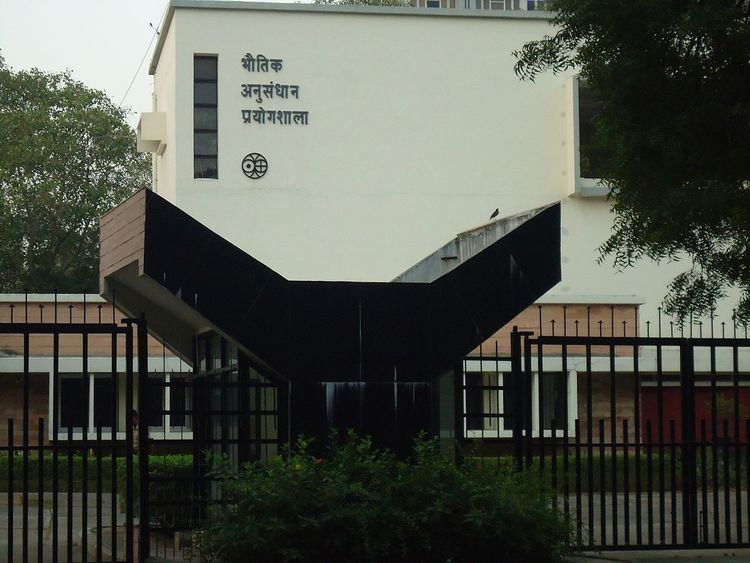The Physical Research Laboratory (PRL) is a National Research Institute for space and allied sciences, supported mainly by Department of Space, Government of India. This research laboratory has ongoing research programmes in astronomy and astrophysics, atmospheric sciences and aeronomy, Earth sciences, Solar System studies and theoretical physics. It manages the Udaipur Solar Observatory and is located in Ahmedabad.
Known as the cradle of space sciences in India, the Physical Research Laboratory (PRL) was founded on 11 November 1947 by Dr. Vikram Sarabhai. PRL had a modest beginning at his residence, the RETREAT, with research on cosmic rays.
The institute was formally established at the M.G. Science Institute, Ahmedabad, with support from the Karmkshetra Educational Foundation and the Ahmedabad Education Society. Prof. Kalpathi Ramakrishna Ramanathan was the first Director of the institute. The initial focus was research on cosmic rays and the properties of the upper atmosphere. Research areas were expanded to include theoretical physics and radio physics later with grants from the Atomic Energy Commission.
Today PRL is actively involved in research, related to five major fields of science. PRL is also instrumental in the PLANEX planetary science and exploration programme.
PRL research encompasses astrophysics, Solar System and cosmic radiation.
Astronomy and astrophysics: Current research programmes include studies on star formation, evolution of intermediate mass stars, photometric and polarimetric studies of active galaxies and BL Lac objects and high angular resolution studies by lunar occulations, study on circumstellar structure. The astronomical observations are taken through a 1.2 m telescope that is located in Mount Abu. The laboratory has also undertaken solar photospheric and chromospheric studies under the International Global Oscillations Network Group (GONG) project at Udaipur Solar Observatory. A 12 ft SPAR telescope is being used in this project.Planetary sciences and PLANEX:study of planetary sciences and explorationPlanetary atmospheres and aeronomy: The institute has been recently investigating the electric and magnetic fields, plasma instabilities and the dynamics of the upper atmosphere are being carried out by elegant radio, optical and plasma diagnostic techniques. The role of trace gases in the chemical and radiative properties of the Earth's atmosphere and their impact on climate, ionization and electrodynamical parameters of the middle atmosphere are a few of the topics which are also being studied actively.Earth sciences: Studies that are particularly related to geochronology, geochemistry, glaciology, oceanography and palaeoclimatology are carried out in this institute. Isotope geology is one of the most actively researched upon subjects.Theoretical physics: Current research programmes include neutrino physics, physics beyond standard model, standard and non-standard CP violation, Fermion masses, super-symmetry, baryogenesis, phenomenology of higher-dimensional theories, QCD and quark gluon plasma, colour superconductivity, chiral symmetry breaking, study of quantum chaos in nuclear energy levels, group theoretical models and nuclear structures, study of atomic Rydberg states, stark spectroscopy of atomic levels, stability analysis of synchronised structures in coupled map networks.Quantum optics and quantum information: Production and characterisation of entangled states, cavity QED, realisation of quantum gates and networks, storage and retrieval of quantum information, subluminal and superluminal propagation of light, dynamics of Bose-Einstein condensates and cold Fermions, non-commutative field theory, solitons, optical resonators and optical fibres are currently studied theoretically. Experimental study of optical vortices is also pursued.The Physical Research Laboratory holds various seminars and public lectures. It has a workshop, computer centre, library and various other laboratories. It also offers a five-year doctoral programme in physics, with specialisations in theoretical physics and complex systems, outer space and atmospheric sciences, quantum optics and quantum information, astronomy and astrophysics (infrared, sub-mm and radio astronomy, Solar physics, planetary and geosciences). The admission is through a written test and interview.
The research institution offers national awards to scientists who have made outstanding contributions in the field of science and technology. The awards presented are:
Hari Om Ashram Prerit Senior Scientist AwardHari Om Ashram Prerit Vikram Sarabhai Research Awards, andPRL AwardAayushi award1950s : Cosmic rays, atmospheric sciences1960s : Theoretical physics, radio physics1970s : Earth and planetary sciences infrared astronomy1980s : Particle physics, Solar physics1990s : Laser physics and quantum optics, non-linear dynamics and computational physics, astroparticle physics and cosmology2000s : Quantum information, Solar X-ray Astronomy (SOXS), submillimeter astronomy, planetary exploration2010s : Exoplanet detection
